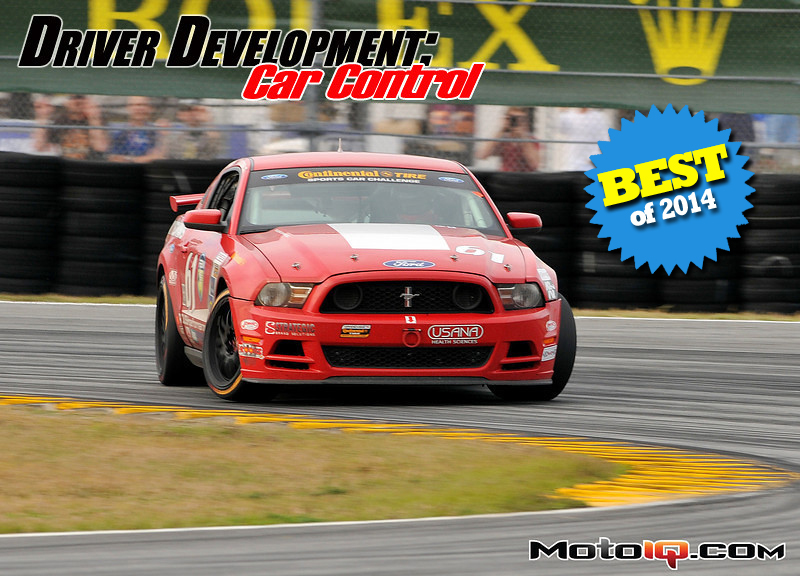UNDER DEVELOPED CAR CONTROL
We will start with the Under Developed driver first. I would define drivers with under developed car control abilities as those who have little confidence, seat time, and experience at or beyond the limit of a tire’s grip. The severity of this can range from beginners and club racers who are timid and afraid of approaching the limit all together to professionals who can win races and are fast but once they exceed that threshold, they don’t have much comfort, confidence, and seat time in this area, are slower in the rain or when a car is set up too loose, and are more prone to mistakes and crashes if something causes the car to oversteer.
This does not mean that drivers with underdeveloped car control are beginners, because driving just below and up to the limit can still be very fast and there are professional drivers who master the ability of staying very close to the limit without surpassing it. Having good car control is not necessary in yaw-sensitive high downforce cars where too much oversteer can cause a snap loose condition and a loss of control. In fact, most top level sports cars and prototypes are so aero dependant that they should not or cannot be driven with any significant yaw angle. So there’s nothing necessarily wrong with under developed car control because it can be driven fast, but the disadvantages usually include taking longer to get up to speed (for the beginner), and a lack of comfort with unintentional rotation/oversteer and in low grip conditions.

The major problem with beginners who are in this category is that many of them never know how far away from the limit they are or the capabilities of their car. Drivers can get stuck in a rut without going faster due to the uncertainty of the limit and the fear that prevents them from increasing their speed to get to it. Without developing the confidence from the next category, it could take a beginner a very long time to work up the confidence to take enough small bites at increasing speed to finally reach the limit. However it’s very common that once they get to this point, they make a mistake and surpass the limit, go off track, spin, and get a scare. Unfortunately this can set them back months to regain their confidence and speed or even worse, they never try approaching the limit again. In other cases a driver’s lack of confidence and fear can be so great to begin with and they only stay at what they perceive as a comfortable pace which can be very far from the limit.
OVER DEVELOPED CAR CONTROL
The next category is the Over Developed driver. These drivers have advanced beyond the under developed car control stage and are comfortable driving a car past the limit, such as drifters and rally car drivers. Over developed drivers have no problem driving under the limit or aggressively sliding well past the limit in order to rotate the car quickly and adjust its yaw angle for drifting or rally racing. Due to their seat time and comfort past the peak lateral load limit and experience with how cars transition into oversteer, it does not take them very long to feel out how a car responds and the severity of inputs needed to make a car rotate or slide. Because of this, they can usually adapt to new tracks and cars in a very short period of time and are comfortable in low grip conditions like rain, snow, and gravel.

However, developing car control skills can be a double edged sword and can possibly lead to a fork in the driving skill road. Once you have gained the power of car control, just like for any superhero, it can be difficult to reel it back in without becoming addicted to your newfound abilities. Like a bad drug, sliding cars is a lot of fun, feels good, but can hurt your end goals in life. I’ve seen many smooth drivers go down the path of over-driving cars with jerky steering inputs better suited for work as a lumberjack as a consequence of gaining this comfort with driving a car sideways. They start to feel that throwing a car sideways in a corner, building up to the limit very quickly, and 4-wheel sliding through a corner with zero steering input to slight countersteer, its faster. But it’s not. Having bad over-driving habits can be a great hindrance in higher-speed corners and especially on cars with racing slicks and yaw-sensitive high downforce GT cars and prototypes, which need smooth steering inputs and have the tendency to snap into an unrecoverable slide with too much rotation.
Having this skill does not inherently make you a faster driver, but it does make for a safer driver who would not spin or crash as often in a road racing environment. This explains how a good drifter isn’t necessarily always going to be a fast road course racer, and how road course racers without highly developed car control can’t necessarily drift all that well. But there are many cases of drivers who can do both to a very high degree. This is similar to how a good shifter kart driver may struggle to be smooth and drive a single-geared sprint kart as fast as a good sprint kart driver can get up to speed in a shifter. This can be a fork in the road between the path of having great car control and being able to slide any car, and the path of becoming a really good road course racer with good car control skills. The latter will take some discipline to be able to reel it back in and optimize the car near the peak of the tire’s friction graph.
REFINED CAR CONTROL
The final category is the refined car control. Drivers with refined car control can balance a car at the peak level of friction, teetering from slightly over the limit to slightly under the limit, keeping area under the friction curve maximized the entire time by not allowing the tires to fall down the friction slope too much in either direction. The refined car control driver also has the comfort and ability to control a car when the limit of traction is passed, but they don’t frequently hang out there. Because of this, these drivers have the same skills and benefits of being able to adapt to new tracks and cars quickly as well as being fast in low grip conditions like rain.
A driver with under developed car control can make it to this ‘refined’ category by slowly creeping into driving over the limit, but it will take seat time driving in this area to become proficient and comfortable with it. The best drivers with under developed car control skills (professionals) usually transition to the refined section eventually. The other path is to re-learn the discipline and finesse that was somewhat lost when transitioning into the over developed car control phase. Reeling back your new found powers to execute driving at the limit and trying not to go beyond it takes patience but in my opinion, will lead to a better all-around driver.

No matter which path is taken, the goal for the racecar driver is to master balancing the car and the tires as close to the top of the tire’s peak friction as possible. The beginner who has the over developed car control skills will tend to overshoot the limit and slide the car too much and then undershoot the recovery. This will not be too much of an issue on street tires, but as the tires and the car’s speed becomes faster, going over the limit will prove to be a bigger issue. The advanced driver will keep the tires closer to their peak than the beginner, and will be a faster driver, especially in faster cars and racing slicks. The expert is what we all strive for, to optimize the tire at all times by keeping it on the verge of sliding, to the point where you are leaving nothing on the table and the only way the car will go faster is by making changes to the car. The expert does not leave anything on the table by driving under the tire’s peak grip level, or let the tire slide which scrubs speed and causes excessive wear.




8 comments
Great article! Had to follow up here after the Speed Secrets weekly left me hanging on the definition of the refined driver!
Thanks for listening in and reading this here!
I have been using a simulator to get more comfortable with driving beyond the limit. On track, as soon as the problem occurs, I generally have the developed muscle memory necessary to get out of the trouble I created. It replaced some of the other questionable methods I used to cut my teeth as a younger adult.
Like Ernie (above), I found this article after reading Ross’s latest Speed Secrets Weekly. I am a club racer, and tend to be very timid about losing control of the car by going past the limit. I took a one day Car Control Clinic at Lime Rock earlier this year, and developed some confidence in going over the limit at low speeds. But at higher speeds, on a dry, fast track, it is still a struggle. I will be driving at Thompson in CT next month, that has some slow corners with wide runoff. I’ll drive on worn out tires, and force myself to do some sliding!
Great article Billy. I have been driving at HPDE’s for 3 years now and agree with what you say. I’ve had some instuctors push me past my current limits and helped me get faster only to come back to the same track and have an instructor slow me down and not let me drive to my current abilities.
Thank you for such detail in the article. I have found my place as a driver just by reading this. Now I can focus on the next area of improvement for myself.
I absolutely enjoyed reading this. This is exactly the Aviation-level, in depth ground school that teaches you how to think about what you’re doing. -And how to understand reality for what it is. I know this will provide a solid foundation for my first HPDE event later this year. Thank you.
Thank you for the feedback, I am glad to hear it!